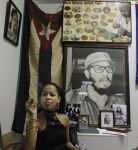by Andrea Rodriguez
HAVANA (AP)—Debora Garcia sat at a table in a room choked with smoke, gently rolling an unbanded cigar between her delicate fingers. She used her thumb to measure its width and length, then held it up to her nose to get a sense of its scent. Finally she wrote down her answer and moved on to the next cigar.
 |
| LIGHTING UP—Ariadna Gomez smokes a cigar next to an image of Cuba’s leader Fidel Castro during the 13th annual Cigar Festival in Havana, Cuba, Feb. 21. (AP Photo/Franklin Reyes)
|
Garcia was one of 27 cigar sommeliers and other experts who took part last week in a blind “tasting” of Cuba’s world-famous smokes—part of the island’s glitzy and glamorous Cigar Festival, which draws many of the biggest vendors from around the world each year.
There were also black-tie dinners, trips to lush tobacco fields, cigar factory tours and lots and lots of schmoozing. The exclusive soirees and jet-set crowd made a strange juxtaposition in a communist country that spends the other 51 weeks of the year proclaiming its egalitarianism and denouncing the excesses of capitalism.
While cigars are extremely popular in Cuba, most citizens can afford only no-name brands that sell in Cuban stores for 1 peso each (about 5 cents).
In the tasting competition, Garcia and other participants first had to identify the type of cigar they held based on its size and the type of leaves used. There are Churchills, Marevas, Robustos, Coronas and Panetelas, to name a few.
After the blindfolds came off, they lit up and tried to guess the brand.
Cuba is awash with famous cigar brands like Cohiba, Romeo y Julieta, Partagas, Montecristo and Robaina, each with its own passionate followers around the world. All are put out by Habanos SA, a joint venture between the Cuban government and the English tobacco giant Altadis.
The most expensive Cuban cigars, currently the Cohiba Behike, can cost upward of $60 each in Europe and Canada. The sale of Cuban cigars is banned in the United States because of the 48-year trade embargo.
This year’s event, which organizers say drew 1,400 aficionados from 80 countries, was held with a mix of optimism and concern. The sale of Cuban cigars ticked up by 2 percent in 2010 to $368 million, the first increase in three years after a dip brought on in part by the global economic meltdown.
But there is also concern for the future of the market as more and more countries approve restrictive smoking laws. Spain, the largest market for Cuban cigars, passed just such a measure in January that bans smoking in all enclosed public spaces.
Even Fidel Castro, perhaps the island’s most famous smoker—and a big fan of Cohibas—gave up the habit years ago, citing health risks. He used to attend the festival’s formal closing dinner each year, but has stayed away since stepping down as president in 2006.
The weeklong festival wrapped up Friday. At the gala dinner, handmade humidors were auctioned off, often for hundreds of thousands of dollars apiece. The proceeds will be donated to Cuba’s free universal health care system.
Garcia, 47, who was the director of quality control at Partagas until a few months ago and still works with Habanos, attributed her cigar-tasting skills to genes, love and hard work.
“There are abilities we are born with, like recognizing tastes,” she said. “But I also train a lot.”
Of the dangers of smoking, and the laws being passed around the world to restrict the habit, Garcia shrugged.
“In modern life everything can hurt you,” she said. “Industrial pollution, car fumes, everything. One must live without fear, and for me, living is impossible without tobacco.”